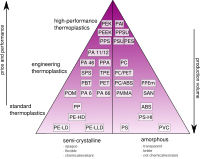
Photo from wikipedia
Photoresponsive soft actuators with the unique merits of flexibility, contactless operation, and remote control have huge potential in technological applications of bionic robotics and biomedical devices. Herein, a facile strategy… Click to show full abstract
Photoresponsive soft actuators with the unique merits of flexibility, contactless operation, and remote control have huge potential in technological applications of bionic robotics and biomedical devices. Herein, a facile strategy was proposed to prepare an intrinsically-photoresponsive elastomer by chemically grafting carbon nanotubes (CNTs) into a thermally-sensitive liquid-crystalline elastomer (LCE) network. Highly effective dispersion and nematic orientation of CNTs in the intrinsic LCE matrix were observed to yield anchoring energies ranging from 1.65 × 10-5 J m-2 to 5.49 × 10-7 J m-2, which significantly enhanced the mechanical and photothermal properties of the photoresponsive elastomer. When embedding an ultralow loading of CNTs (0.1 wt%), the tensile strength of the LCE increased by 420% to 13.89 MPa (||) and 530% to 3.94 MPa (⊥) and exhibited a stable response to repeated alternating cooling and heating cycles, as well as repeated UV and infrared irradiation. Furthermore, the shape transformation, locomotion, and photo-actuation capabilities allow the CNT/LCE actuator to be applied in high-definition biomechanical applications, such as phototactic flowers, serpentine robots and artificial muscles. This design strategy may provide a promising method to manufacture high-precision, remote-control smart devices.
Journal Title: Materials horizons
Year Published: 2022
Link to full text (if available)
Share on Social Media: Sign Up to like & get
recommendations!